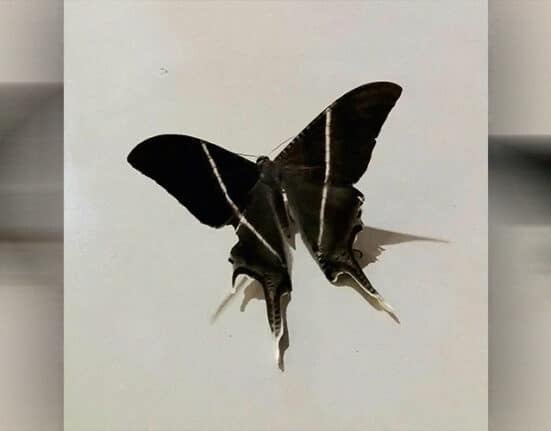A SUDDEN surge in sightings of dark, large moths— identified as tropical swallowtail moths (Lyssa zampa)— has sparked curiosity and concern across Metro Manila and nearby provinces this week.
Residents have taken to social media to share photos of the striking insect, known for its broad, triangular wings patterned in muted shades of brown and gray.
While some netizens marveled at the moth’s striking appearance and impressive wingspan, others expressed concern, noting that such sightings are rare in urban settings.
Tropical swallowtail moths are typically found in forested and mountainous areas, and their sudden presence in cities like Metro Manila has left many wondering about the cause.
In a now viral post, University of the Philippines Diliman biology graduate and aspiring entomologist Edriel Lee shared his concern, citing a 2023 study by Jain, Ng, and Civasothi that documented the same occurrence in Singapore.
“Their findings pointed to several possibilities. One key factor is the lack of available host plants. As food becomes scarce in forests, the moths may be forced to look elsewhere for places where their larvae can feed,” wrote Lee.
According to the study, a dry spell — a period with little to no rain during a normally wet season — can lead to a sudden boom in the population of insects like the tropical swallowtail moth.
When this happens, their host plants can be heavily consumed and eventually depleted due to the overwhelming number of moth caterpillars feeding on them. This pushes the moths to migrate and find another location that contains their food source.
“Now, as you probably know, moths are generally attracted to light. In search of new hosts, they become tempted to detour into the glistening, shimmering urban metropolis. Unfortunately, their host plants from the genus Endospermum—at least in Singapore—can only be found in forests and are absent in cities. As a result, the migrating moths are not able to reproduce,” explained Lee.
He added that this may pose a complication for the genetic health of the species as only those capable of strong flight can survive and pass their traits to the next generation.
“Possibly as a result of increased host plant toxicity, future generations are at risk of developing shorter wings, which may compromise their fitness. Over time, this could contribute to local declines or reduced resilience, especially if new environmental pressures arise,” Lee added.
This turn of events could affect and damage the food web.
As the moths fail to reproduce due to the absence of host plants in urban areas, it could lead to a decline in their population over time. This would not only impact the species itself but also the animals that rely on them as part of their diet.
The incident also raises questions about the health of the forests where these moths typically thrive. If food sources in their natural habitat are indeed dwindling, it may be a sign of broader ecological stress— driven not just by deforestation or pollution, but increasingly by climate change.
“Unfortunately, dry spells are becoming more frequent and prolonged due to global warming. The appearance of these moths could be another sign of that, and we may begin to see more phenomena like this over time,” Lee said.
“So the next time we see a tropical swallowtail moth, I hope it prompts us to reflect on what we can do to help protect Mother Earth.”
How useful was this post?
Click on a star to rate it!
Average rating 4.7 / 5. Vote count: 56
No votes so far! Be the first to rate this post.
We are sorry that this post was not useful for you!
Let us improve this post!
Tell us how we can improve this post?




